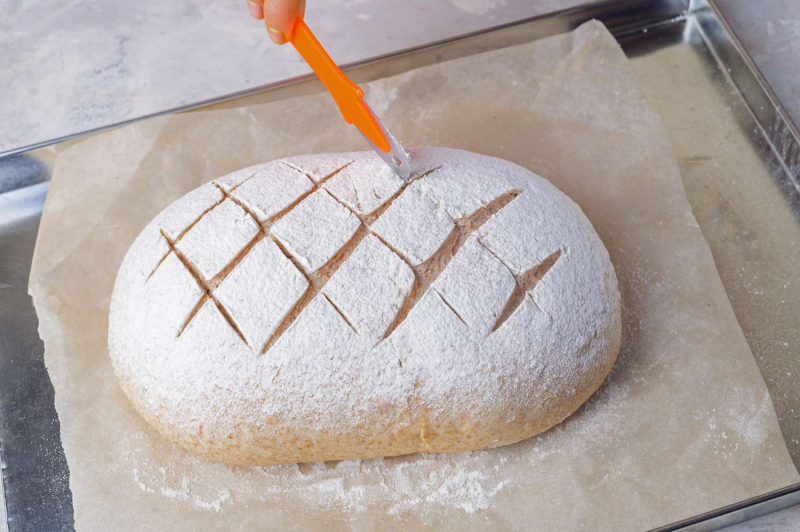And How You Can Get Your Loaves to Look Like the Pros
One of the ways you can tell a loaf of bread baked by a professional from one baked by a novice baker is by the scoring. Scoring is a way of making shallow cuts in the tops of the unbaked bread dough right before baking it. What you see as a result when the bread comes out of the oven is anything from a simple curved ridge to an elaborate array of leaves or even stalks of wheat.
But scoring bread is more than just decorative. Let's take a look at the whys, hows and whens of scoring bread.
What Does Scoring Bread Do?
When you properly shape a ball of dough, you’re creating a very taut surface on it. And when subjected to the sudden burst of gas that’s produced by the yeast when the dough enters the hot oven (an effect known as “oven spring”), that surface can easily rupture along any weak spots in the dough ball.
These ruptures can occur anywhere, and produce large, raggedly shaped holes in the top of the bread. Alternately, you might have what's called a blowout, where an appendage-like lump comes protruding out of the top, side or even the bottom of the loaf.
Scoring is a way of controlling where these ruptures occur, so that the gas can escape without destroying the bread.
Not only does scoring help produce good bread, it also allows you to give a unique and decorative touch to each loaf. By slashing particular patterns in the top of the loaf, you can produce a striking, artistic effect that makes your loaves look like they were baked by a professional.
But whether you go for the artistic approach or simply opt for a single straight slash, the ultimate goal is to vent the gas in a controlled manner so that the dough rises in a consistent way.

How to Score Bread
While it is possible to describe how to score bread using words alone, your best bet is to watch a video that shows hows it's done, then start practicing it yourself until you get the hang of it. The same goes for the kinds of scoring patterns bakers use. A few pointers, however:
- Make sure your blade is very sharp.
- Make your slashes swift and make them with confidence and authority.
- Don’t press down on the dough, but rather let the blade do the work.
- Make the cuts using your whole arm, not your wrist.
- It can help to wet your blade, or even spray it with oil, so that you get smooth cuts rather than ragged ones—particularly if your dough is especially sticky.
- Cold dough is easier to score, so it might help to chill it before scoring (although this may have unintended consequences).
- Once it’s scored, bake it right away as you have now punctured the glutens and the dough will start to deflate.
Types of Scoring Patterns
What type of scoring pattern you use will in part depend on the shape of the loaf of bread you’re baking. A round boule, for instance, will often get an X-shaped score, or one resembling a hashtag symbol, while a long baguette will traditionally get a series of diagonal slashes. A batard, which is an oblong shape midway between a baguette and a boule, can take between two and four diagonal slashes, or just a single long one. But the possibilities are endless.
What Is an Ear?
It's a raised ridge of crust along one edge of a cut, almost like a handle. You can, in fact, hold the finished loaf by it. In addition to its distinctive visual appeal, an ear gives the bread a crunchy edge at that section of the loaf. An ear is achieved by using a curved blade and holding it at a low angle (about 30 degrees) that gets just under the skin of the dough, rather than a straight cut which releases the bread laterally.
Tools for Scoring Bread
Professional bakers use a special tool called a lame (pronounced like the word "lamb"), which is basically a straight or curved razor blade mounted on a short handle. Straight blades produce cuts that are straight and form straight slashes when the dough expands, while curved blades produce almond-shaped slashes and are perfect for producing an "ear."
Bakers' lames are fairly inexpensive—a decent one will run less than 20 bucks. But you can also use a simple box cutter. A sharp kitchen knife can also work, but in general a razor blade will produce a better result. And if you're looking to make almond shaped slashes, such as on a baguette, you'll need to use a curved lame, not a box cutter or razor.
